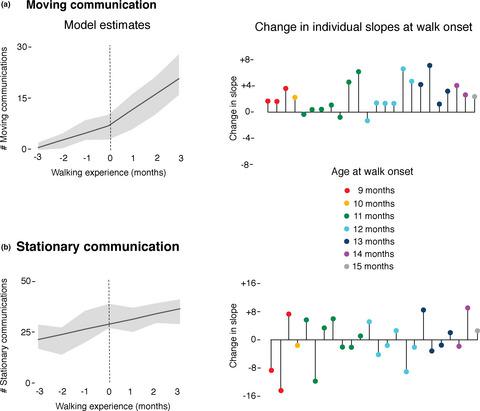Our official English website, www.x-mol.net, welcomes your feedback! (Note: you will need to create a separate account there.)
Communication changes when infants begin to walk
Developmental Science ( IF 4.939 ) Pub Date : 2021-02-08 , DOI: 10.1111/desc.13102 Kelsey L West 1 , Jana M Iverson 2
Developmental Science ( IF 4.939 ) Pub Date : 2021-02-08 , DOI: 10.1111/desc.13102 Kelsey L West 1 , Jana M Iverson 2
Affiliation

|
Learning to walk allows infants to travel faster and farther and explore more of their environments. In turn, walking may have a cascading effect on infants’ communication and subsequent responses from caregivers. We tested for an inflection point—a dramatic shift in the developmental progression—in infant communication and caregiver responses when infants started walking. We followed 25 infants longitudinally over 7 months surrounding the onset of walking (mean walk onset age = 11.76 months, SD = 1.56). After learning to walk, the pace of gesture growth (but not vocalization growth) increased substantially, and infants increasingly coordinated gestures and vocalizations with locomotion (e.g., by walking to a caregiver and showing off a toy bear). Consequently, caregivers had more opportunities to respond contingently to their infants during walking months compared to crawling months (e.g., “What did you find? Is that your bear?”). Changes in communication were amplified for infants who began walking at older ages, compared to younger walkers. Findings suggest that learning to walk marks a point in development when infants actively communicate in new ways, and consequently elicit rich verbal input from caregivers.
中文翻译:

当婴儿开始走路时交流会发生变化
学习走路可以让婴儿走得更快更远,探索更多的环境。反过来,步行可能对婴儿的交流和照顾者的后续反应产生级联效应。我们测试了婴儿开始走路时婴儿交流和照顾者反应的拐点——发育进程的巨大转变。我们在步行开始前后 7 个月内纵向跟踪了 25 名婴儿(平均步行开始年龄 = 11.76 个月,SD = 1.56)。在学会走路后,手势增长(但不是发声增长)的速度显着增加,婴儿越来越多地协调手势和发声与运动(例如,通过走向看护人和炫耀玩具熊)。因此,与爬行月份相比,看护者在步行月份有更多机会对他们的婴儿做出偶然反应(例如,“你发现了什么?那是你的熊吗?”)。与年轻的步行者相比,年龄较大的婴儿开始走路时交流的变化被放大了。研究结果表明,当婴儿以新的方式积极交流时,学会走路标志着发育的一个点,并因此从照顾者那里得到丰富的口头输入。
更新日期:2021-02-08
中文翻译:

当婴儿开始走路时交流会发生变化
学习走路可以让婴儿走得更快更远,探索更多的环境。反过来,步行可能对婴儿的交流和照顾者的后续反应产生级联效应。我们测试了婴儿开始走路时婴儿交流和照顾者反应的拐点——发育进程的巨大转变。我们在步行开始前后 7 个月内纵向跟踪了 25 名婴儿(平均步行开始年龄 = 11.76 个月,SD = 1.56)。在学会走路后,手势增长(但不是发声增长)的速度显着增加,婴儿越来越多地协调手势和发声与运动(例如,通过走向看护人和炫耀玩具熊)。因此,与爬行月份相比,看护者在步行月份有更多机会对他们的婴儿做出偶然反应(例如,“你发现了什么?那是你的熊吗?”)。与年轻的步行者相比,年龄较大的婴儿开始走路时交流的变化被放大了。研究结果表明,当婴儿以新的方式积极交流时,学会走路标志着发育的一个点,并因此从照顾者那里得到丰富的口头输入。


























 京公网安备 11010802027423号
京公网安备 11010802027423号